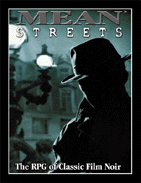
|
About OgreCave and its staff
|

|
by Demian Katz
Mean Streets, a 59-page downloadable role-playing game inspired by the Film Noir genre popularized by Hollywood during the forties and fifties, is the first game based around Deep7's XPG system, the game engine that will be featured in the much-anticipated Red Dwarf RPG. In terms of complexity, the rules are somewhere between the company's popular and fast-playing 1PG line and its more complicated Arrowflight system, though players familiar with either previous system should have no trouble adapting to this one. Most of the book's first eighteen pages are devoted to a description of the rules. Character creation is entirely point-based, featuring the same six attributes used in Arrowflight (Agility, Dexterity, Strength, Perception, Intelligence and Willpower) along with a decent assortment of genre-appropriate skills. Game mechanics involve setting a target number (the sum of the appropriate skill score and its related attribute) and attempting to roll under this number (possibly with modifications) using two six-sided dice. The rules cover opposed rolls (which are used for combat resolution, among other things) and methods for measuring varying degrees of success. This isn't exactly an innovative system, but it's a comfortable and effective one -- it's not as random as the 1PG system and it's free from the pointlessly strange dice-rolling mechanics and combat-related overhead found in Arrowflight. Although the lines between some of the attributes are a little hard to define and a couple of concepts (particularly critical successes) could have been described more clearly, the book does a good job of presenting its system in an efficient and comprehensible way. Immediately following the rules, the book contains two chapters filled with background material. The first of these chapters describes the people, places and significant events of the game's default setting, New York City circa 1943, presenting an interesting assortment of historical facts mixed with enough cinematic touches to help the game stay true to its source material. This is probably the most engaging segment of the book, particularly valuable as a seed for a feds vs. gangsters campaign thanks to its emphasis on city government and the gangs that plague it. The following chapter, "Mastering Film Noir," describes a bit of the history of Film Noir and attempts to help the GM set the proper tone. Despite some helpful details here, there are also a lot of less-than-helpful generalities; unsurprisingly, a good day's film festival would probably be a better initiation to the genre than this chapter. However, it's worth reading through for its tips on creating workable campaigns with gaming groups of various sizes and its notes on dealing appropriately with women in the often misogynistic Film Noir world. With rules and background in place, the book proceeds to its lowest point: a ten-page sample adventure called "A Tangled Web." The adventure is inspired by Fritz Lang's 1953 film The Big Heat, and it seems to follow the film fairly closely, though the character names have all been changed. Unfortunately, the adventure doesn't strike me as something I'd ever want to run. It's extremely linear, it's short on clues and direction for the players, details about its characters are scattered throughout the text rather than being collected in a convenient location, and it doesn't even feature an especially interesting plot. It wouldn't have cost the author too much effort to come up with something original featuring a similar but more RPG-friendly storyline, and that would have eliminated the risk that one of the players will figure out which movie he or she has fallen into and ruin everything. The book is rounded out with a useful equipment list, a somewhat disappointing filmography featuring several plot summaries swiped (with attribution, at least) from the Internet Movie Database, a collection of generic NPC stats, a period-appropriate map of New York and (bless everyone involved) an index. The final two pages of the game's file are devoted to a plain but functional character sheet. As for look & feel, the game's layout is largely professional-looking, and I especially liked the shadowy, fedora-wearing figure that lurks in the background of the introductory page of each chapter. While most of the other artwork is less dramatic, being a combination of line drawings of moderate quality and the digitally-altered photographs that Deep7 employs so frequently as 1PG cover art, it is at least appropriate to the subject matter and not too wasteful of space. My biggest aesthetic complaint is that the page numbers are laid out with two-sided printing in mind, making the game look a little weird if you prefer one-sided printing or if you skip printing the cover to save toner, thus ending up with the page numbers all printed on the wrong corners of the pages. At $7.95 (plus printing costs), I'd say Mean Streets is only a moderate value. The workable game system and well-written background material are set against a mediocre introductory adventure and overall brevity. If you're a Film Noir fan looking for a system to use, this is a simple and straightforward one that should lead to quite a bit of enjoyment. If you're simply a gamer looking for something new to try, however, this might not be the best choice for you.
|
||
 Mean Streets: The RPG of Classic Film Noir
Mean Streets: The RPG of Classic Film Noir